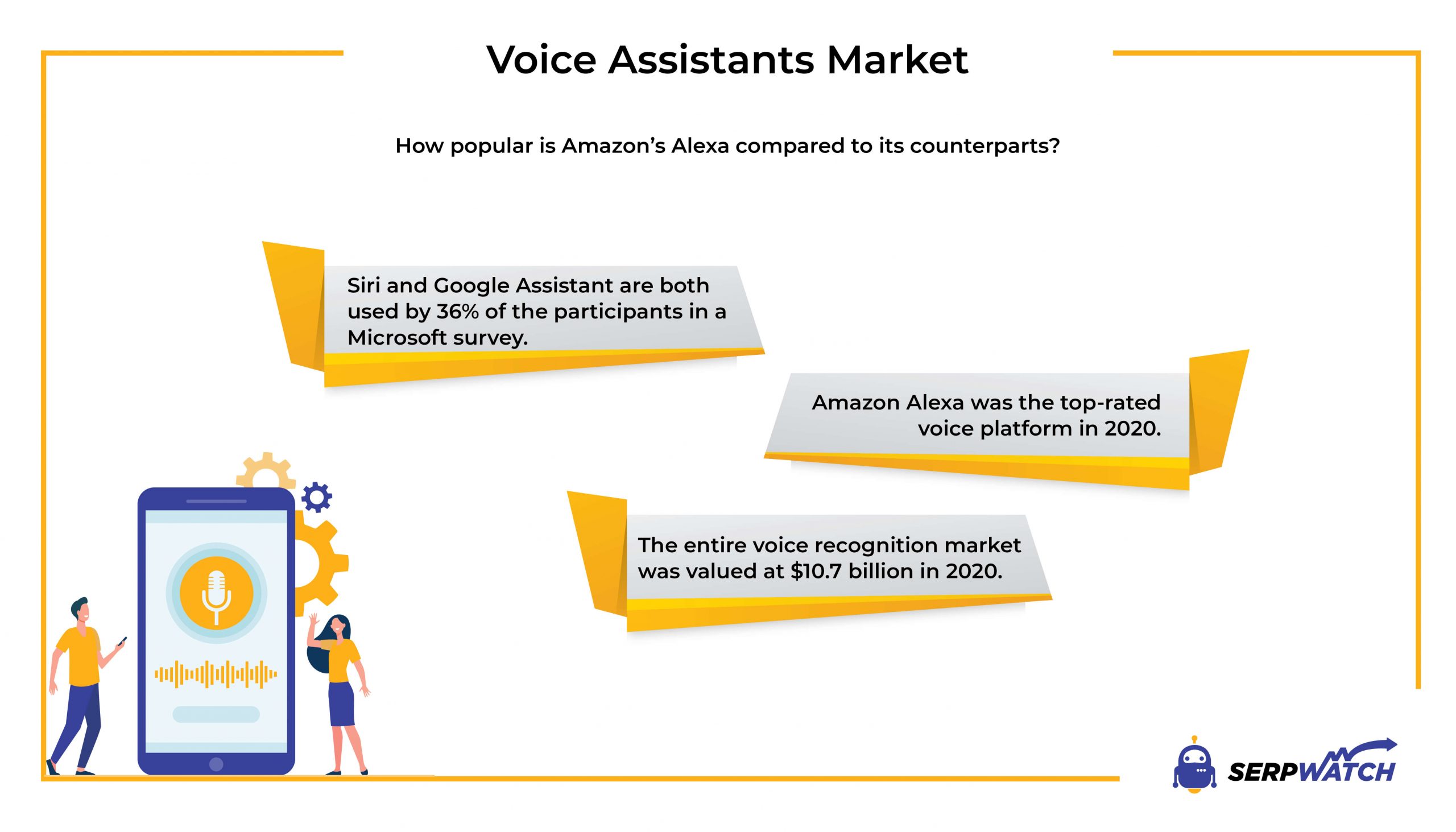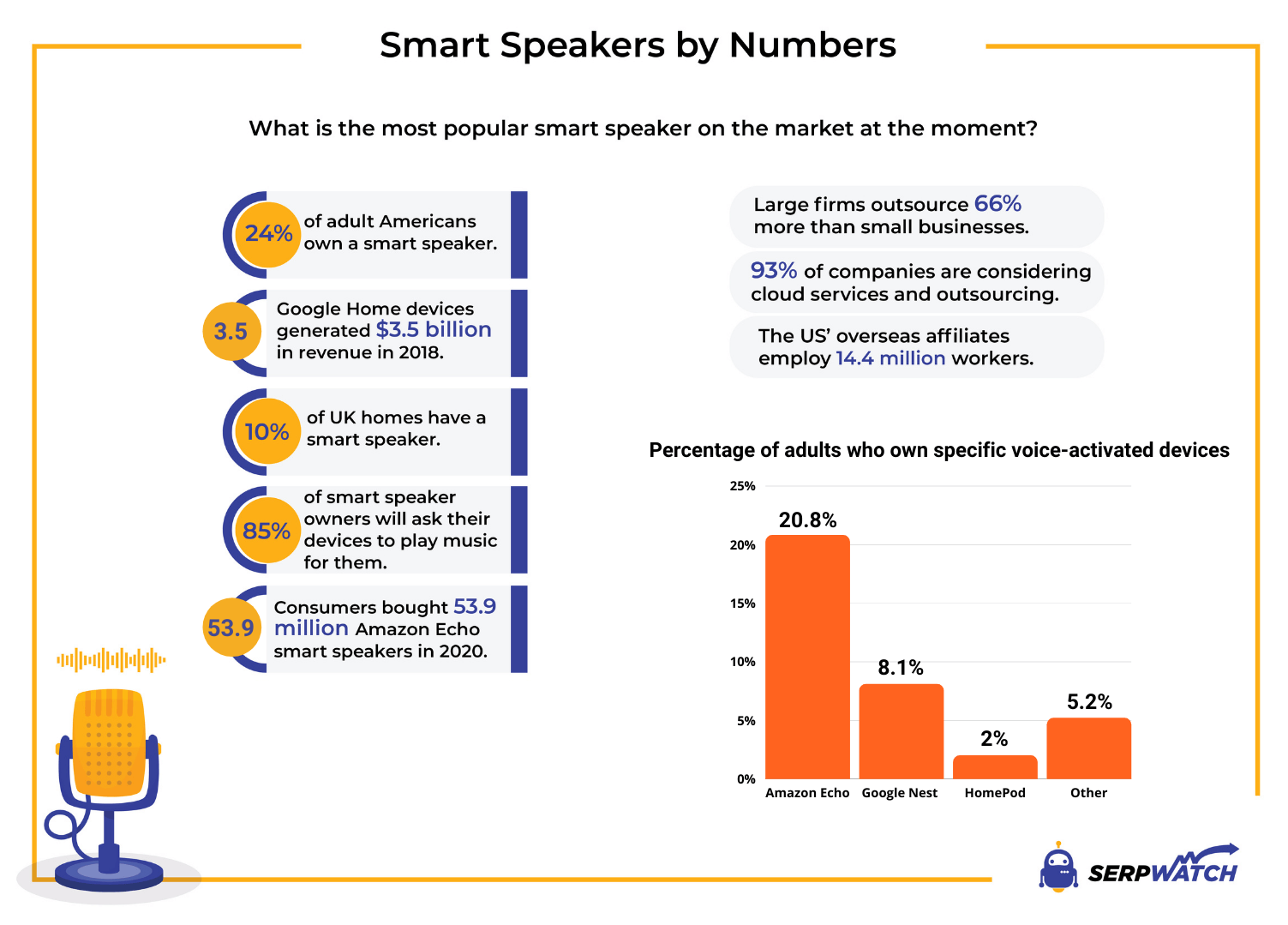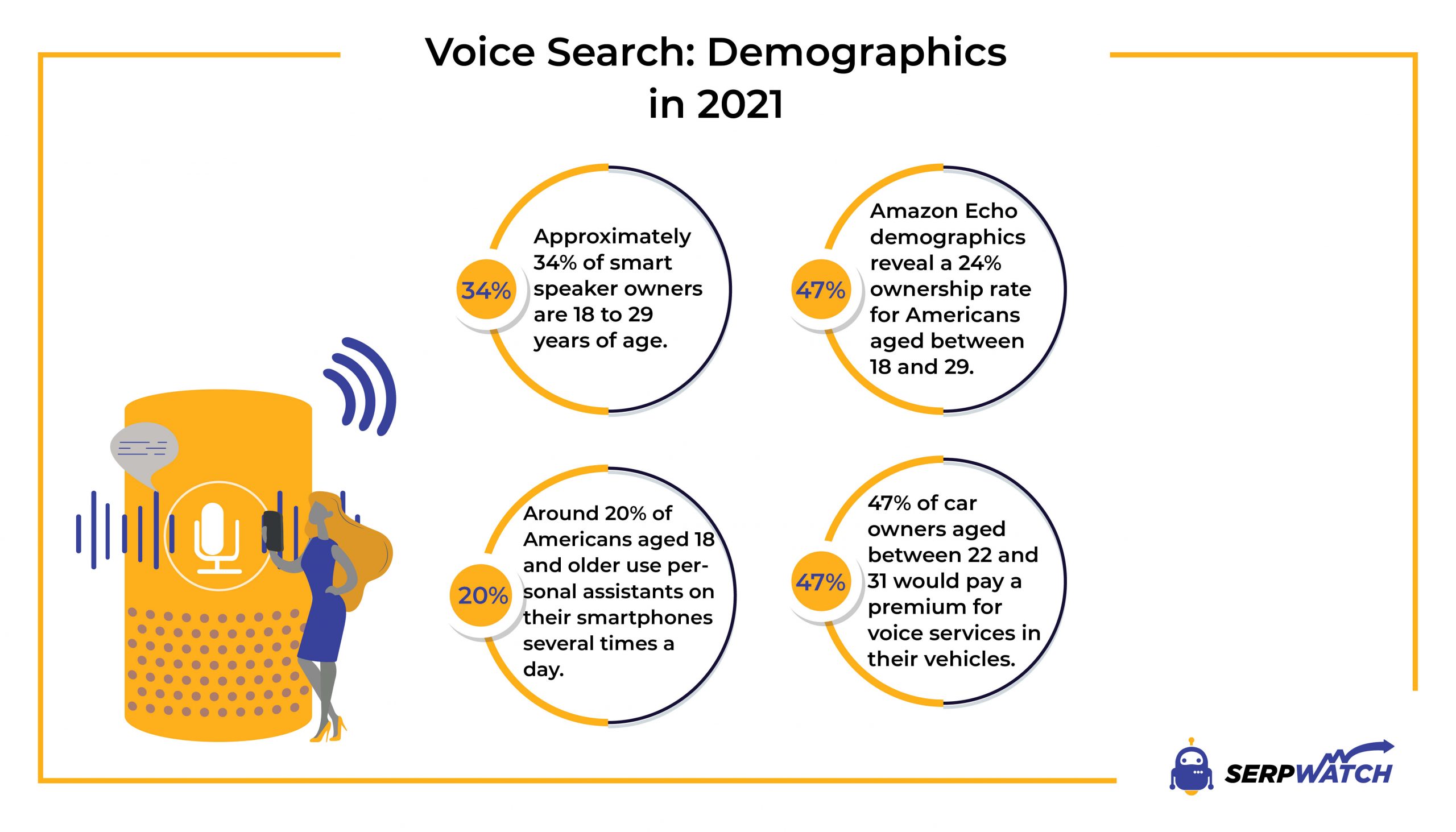
Voice Search Statistics: Smart Speakers, Voice Assistants, and Users in 2024

The latest advancements in technology have made voice searching more accessible than ever. In today’s time, virtually every modern-day smartphone is equipped with a personal assistant that can be activated via voice. Not only that, but many people also buy smart speakers that can answer your questions, play your favorite music, and much more.
Whether it’s because of convenience, entertainment, or any other reason, the latest stats show that voice search is a part of a daily routine for millions of people. It’s also one of the biggest reasons why business owners should optimize their websites for voice search.
Top Voice Search Statistics | Editor’s Choice
- The latest data shows there are 4.2 billion digital voice assistants worldwide.
- Siri and Google Assistant are the most popular digital assistants, with 36% of users each.
- The entire voice recognition market was valued at $10.7 billion in 2020.
- Amazon Alexa was the top-rated voice platform in 2020 with 110.2 points.
- 68% of voice assistants users agree personal assistants make their lives easier.
- An average voice search result is just 29 words long.
- Around 46% of voice search users search for local businesses each day.
- Voice assistant users conduct 3.1 billion voice searches each month.
- 24% of Americans aged 18–29 own a smart speaker.
General Voice Search Statistics
If you consider that 90.63% of content doesn’t get traffic from Google, you will quickly realize that SEO is essential for a successful digital marketing campaign. It can help promote your brand and ensure that the right audience sees your product or services.
Furthermore, SEO benefits greatly from tools like SerpWatch that can help you research and track relevant keywords and use them to optimize your content.
In today’s time, it’s also important to consider optimizing for voice search when creating an SEO strategy since more and more users use voice when making an inquiry or looking for a product. With that said, the following statistics should give you a general idea of how voice search works, the latest voice search trends, how many people use voice search, and much more.
1. Around 63% of US adults use a voice-operated assistant.
Of that number, 53% use a voice assistant on their phone, 24% on a TV or TV remote, 23% in a car, and only 9% on a household appliance. Interestingly, only 21% of those who use a personal assistant use it on their computer.
2. Google Assistant supports more than 50,000 smart home devices.
Based on the latest Google voice search statistics for 2021, Google Assistant is one of the most implemented AI-powered virtual assistants. The latest information from Google Support reveals that it’s compatible with more than 10,000 popular brands, and the number is increasing by the day.
3. Only 51% of smartphone voice users make a voice request for their devices to play music.
While smart speaker owners most often use their devices to play music, smartphone users have different requests in a typical week. Mobile voice search statistics reveal that 40% of smartphone voice users check the time at least once a week, and 21% use voice commands to receive reminders.
Additionally, 58% of them check the weather, 47% set the alarm, and 46% use a personal voice assistant to make a phone call.
4. 56% of people who use a voice assistant keep the assistant turned on all the time.
Interestingly, even owning a smart speaker may increase the frequency of using a voice assistant. In fact, the latest voice technology trends show that 46% of smart speaker owners have used a voice-operated personal assistant on their smartphone a lot more since they got a smart speaker.
5. 62% of smartphone users in the US use their voice assistants when driving.
Smartphone owners often use their voice assistants when their hands are occupied, which is one of the reasons they use voice commands when driving to ask for directions.
Additionally, 38% of smartphone owners use a voice assistant when relaxing at home, 26% when doing chores around the house, and 24% use it while cooking to find recipes.
6. Statistics on voice search growth show that 91% of brands are heavily investing in the voice market.
Many brands believe voice search is the future, which is just one of the reasons they invest in voice technology. However, while voice technology has come a long way, there is still room for improvement.
Namely, even though 94% of users claim that technology is easy to use and improves the quality of life, 49% of respondents say they often don’t know where to begin accomplishing a task.
7. There are around 4.2 billion digital voice assistants in use worldwide.
The latest voice search data for 2021 shows that the number of devices supporting a voice-operated assistant is increasing since there were 3.25 billion devices in use in 2019. According to Statista, the latest research projects that there will be 8.4 billion voice-operated devices in use by 2024.
8. Voice shopping generated more than $2 billion in sales in 2020.
Furthermore, voice shopping revenue is expected to skyrocket by next year. Namely, based on the latest statistics, the voice shopping market is estimated to reach $40 billion by 2022.
Voice Assistant Market Statistics
Voice assistants come in various forms. While some are installed in vehicles or household appliances, most come as smart speakers or a part of modern-day smartphones. Naturally, that means that the biggest voice market share is reserved for brands that develop voice assistants for such devices.
With that said, the following statistics will tell you more about those brands and their market share. Furthermore, you will find out what the size of the global voice market is and more.

9. Voice assistant statistics for 2021 show that Siri and Google Assistant are both used by 36% of the participants in a Microsoft survey.
Based on the latest data available on Statista, Google Assistant and Apple’s Siri are toe to toe in terms of popularity.
In addition, other popular digital assistants include Amazon Alexa with 25% and Microsoft Cortana with 19% of users, while only 1% of respondents reported using other digital assistants.
10. The entire voice recognition market was valued at $10.7 billion in 2020.
The newest statistics on voice search growth rates indicate that the voice recognition market is continuously growing. According to the latest research reports, the market is estimated to reach $27.1 billion by 2026, growing at a compound annual growth rate of 16.8% from 2021 to 2026.
11. Amazon Alexa was the top-rated voice platform in 2020 with 110.2 points.
The score is based on Voicebot’s voice platform impact rating that ranges from -250 to 250 and represents the adoption and intent expressed by industry professionals to support the ecosystems.
Based on the same voice search stats and ratings, Google Assistant had 97.3 points, followed by Apple’s Siri with 38.3, Samsung Bixby with 25.5, and SoundHound with 11.0 points.
12. Amazon Echo and Alexa dominate the US market with a stunning 70% market share.
Alexa’s market share shouldn’t come as a surprise when combined with Amazon Echo, mainly because Amazon Echo is one of the best-selling smart speakers across the globe. It’s also one of the most sought-after smart speakers in the US. While the latest statistics show that the two have a combined market share of 70%, many analysts predict this trend will continue in the following year.
Smart Speaker Statistics
Smart speakers are devices that have an integrated virtual assistant. Just like voice assistants on your smartphone, they can be activated via voice and a specific command and used for shopping, playing music, answering general questions, and much more.
The following statistics will give you a better insight into the smart speaker market and show why voice searching is one of the newest trends, with so many households already owning a smart speaker.

13. 24% of adult Americans own a smart speaker.
According to the latest voice search statistics for 2021, this percentage equals around 60 million people. This marks a significant increase from 2019 when 53 million adult Americans reported having a smart speaker. Of that number, 47% of Americans use one speaker, 24% own two, and 29% have three or more smart speakers.
14. 66% of surveyed smart speaker non-owners are bothered that voice-enabled smart speakers are always listening.
Additionally, 65% of survey participants say that they don’t own a smart speaker because they are worried hackers may use the devices to access their personal information. At the same time, voice search trends for 2021 show that 58% don’t trust the companies that make smart speakers to keep their information secure, while 46% worry that the government may use smart speakers to listen to their private conversations.
15. In a typical week, 85% of smart speaker owners ask their devices to play music for them.
Aside from playing music, there are other ways smart speaker owners use their devices throughout the week. Voice-based search usage statistics show that 62% check the time, and 74% check the weather.
Additionally, 42% of surveyed participants ask the device to receive a reminder at least once a week, while 32% use their smart speakers to make a phone call. Lastly, 65% of survey participants use their smart speakers to set the alarm.
16. Google Home devices generated $3.5 billion in revenue in 2018.
Based on the Google Home revenue reports, Google is earning billions in revenue from the sales of Google Home smart speakers. Furthermore, it’s projected that the number of sold Google smart speakers will reach 140 million by 2025, which is a significant increase from 12.5 million units sold in 2018.
17. Approximately 87.7 million US adults reported using a smart speaker in 2020.
In other words, 34.4% of the adult US population owns a smart speaker. The latest statistics show that this presents a 32% increase compared to January 2019. Moreover, it’s also an 85% increase compared to January 2018.
18. UK voice search statistics for 2021 shows at least 10% of UK homes have a smart speaker.
Even though 44% of smart speaker owners in the UK have used their devices to make a purchase at least once, only 16% of them use smart speakers regularly for online shopping. For comparison purposes, a third of smart speaker owners in the US use their devices to shop online regularly.
19. China shipped 58.9 million smart speakers across the globe in 2020.
China is by far the largest exporter of smart speaker units. In 2020, 126.5 million devices were shipped worldwide, out of which China shipped more than half.
North America shipped 38 million, and Europe, Middle East, and Africa combined shipped 18.2 million in total. Additionally, Latin America shipped 1.6 million units.
20. Amazon has the biggest smart speaker market share with 28.3% in the Q4 of 2020.
The latest statistics show that Amazon is the leading vendor when it comes to smart speaker sales worldwide.
It’s followed by Google with 22.6%, Baidu with 11.3%, Alibaba with 10.8%, and Xiaomi with 6.5%. When it comes to Apple, the company has a market share of 7.8%, while 12.6% is reserved for other brands.
21. Consumers bought 53.9 million Amazon Echo smart speakers in 2020.
Amazon Echo sales figures show that the sales of these particular speakers are on the rise. Namely, in 2017, the company sold only around 26.2 million units and the number doubled in just three years. Amazon will ship about 130 million units of Amazon Echo smart speakers by 2025.
Interesting User Statistics on Voice Search
The statistics show that more and more people use voice search as a part of their daily routine. To help you learn more about it, we’ve prepared several statistics to show you what consumers think of their voice search devices and what improvements they would like to see.

22. Approximately 25.9% of Australian households have a smart home.
The latest data shows that nearly a third of all Australian households have a smart home. Furthermore, since the country follows the modern-day voice trends, the newest voice statistics for Australia reveal that approximately 57% of Australians use voice search.
23. 68% of users think that voice-operated personal assistants have made their life easier.
Not only that, but 65% of surveyed Americans also think that voice-operated personal assistant technology has significantly improved in the past few years. Perhaps that’s the reason why 41% of them wouldn’t want to go back to a life without voice-operated personal assistants.
24. Based on the latest voice search trends, 45% of consumers said they would prefer if their favorite apps had voice assistant features.
As things stand today, you can use a voice command to get your digital assistant to open an app for you. However, once you open the app, you can’t use voice to navigate through the app, which a lot of consumers would prefer. On the other hand, 30.1% of users said they weren’t sure if they wanted to use voice to navigate through apps, 17.8% reported “I don’t think so,” while 7.1% said, “definitely not.”
25. Voice search statistics worldwide show that the usage of voice assistants increased by 7% worldwide as of March 2020.
The COVID-19 pandemic has affected virtually everyone across the globe. The restrictions and lockdowns caused by the pandemic resulted in a 70% increase in the use of laptops and smartphones, which consequently affected the usage of personal voice assistants.
26. According to the latest voice search statistics, security is the main concern for 42% of voice shoppers in the US.
Although many consumers already use a smartphone or smart speaker voice assistants to shop online, some refrain from using voice assistants for shopping. Apart from security, 31% of consumers are worried they might order a wrong brand or an item, while 26% are concerned about ordering duplicate items by accident.
Voice Search SEO Statistics
SEO is an integral part of digital marketing, and businesses use it to deliver their products and services to the right consumers. Even though optimizing for voice is a tad different from optimizing long-form content on a website, it’s still based on general SEO principles.
In other words, businesses can use apps like SerpWatch to research keywords or track them to create an optimized strategy.
If you wish to learn a little bit more about how to optimize your website for voice, we’ve prepared a few voice search SEO statistics to help you get started.
27. It takes around 4.6 seconds for an average voice search results page to load.
This is slightly longer compared to text-based queries, where the average load speed for the top-ranking websites is 1.9 seconds. However, apart from speed, your domain rating can also affect your website rankings.
Based on the latest data, authoritative domains produce voice search results more often than non-authoritative domains. Moreover, 75% of voice search results that rank well in desktop search will appear in the top three for voice search queries.
28. An average voice search result is 29 words long.
The latest voice search SEO studies for 2021 indicate that Google prefers brief and concise answers to voice search queries. However, keep in mind that an average word count of a voice search results page is around 2,312 words, meaning that Google extracts answers from long-form content. Furthermore, the same study shows that an average Google voice search result is written at a 9th-grade level.
29. Around 46% of voice search users search for local businesses each day.
Additionally, the newest voice technology trends show that 76% of smart speaker owners use their devices to search for a local business at least once a week. Of those who use voice search to look for local businesses, 27% follow up on their search and visit the website. Some of the most common searches include looking for restaurants, food delivery, or grocery stores.
30. Voice assistant users conduct 3.1 billion voice searches each month.
Google users perform 63,000 searches per second, and many of those searches are voice searches. The latest voice search trends for 2021 show that half of the voice search results are pulled from featured snippets when using voice search. Additionally, out of those who use voice to find information online, 55% search for local businesses.
Voice Search Demographics
The following statistics will give you a better insight into voice search demographics and show you who uses voice-based personal assistants. Furthermore, we will show you how frequently voice assistants are used as well as what users think of voice assistants in their vehicles.
31. Amazon Echo demographics reveal a 24% ownership rate for Americans aged between 18 and 29.
The latest data shows that younger generations are more likely to own Amazon Echo smart speakers. The ownership decreases among the older population. For example, the ownership rate among adults aged between 30 and 44 is around 20%. Additionally, it’s estimated that around 14% of Americans aged between 45 and 54 own an Echo.
32. Approximately 34% of smart speaker owners are 18 to 29 years of age.
Additionally, statistics on voice search show that 29% of smart speaker owners are aged 30 to 44, 26.2% are aged 45 to 60, and 20.1% of survey participants aged 60 or older use a smart speaker. Interestingly, while seniors are less likely to own a smart speaker, those aged 60 or older who already own a smart speaker are more likely to use it daily than those aged 30 or younger.
33. Around 20% of Americans aged 18 and older use personal assistants on their smartphones several times a day.
If we take a look at the history of voice search and data from 2019, we can see that the usage of personal assistants increased. Namely, in 2019, 19% of surveyed users reported using a personal assistant on their smartphone once a day, 17% nearly every day, and only 17% at least once a week. For comparison purposes, in 2020, 21% reported using a voice-operated smartphone assistant nearly every day, while 22% reported using it at least once a week.
34. 80.5% of respondents aged 18 to 29 have used a voice assistant on their smartphone at least once.
Virtually all modern-day smartphones come with a built-in digital assistant. Based on the latest voice assistant statistics for 2021, many smartphone owners have reported using voice assistants at least once after getting a smartphone.
In addition, 74.7% of smartphone owners aged 30 to 44 and 68.8% of those aged 45 to 60 have used a digital assistant. Lastly, even 60.5% of seniors aged 60 or older have reported using a voice assistant at least once.
35. 47% of car owners aged between 22 and 31 would pay a premium for voice services in their vehicles.
Although Google Home doesn’t have a monthly cost and virtually all voice assistants are free to use, many younger car owners would pay a premium price if voice assistants in their vehicles were better.
Namely, 28% of consumers said they were satisfied with car voice assistants and would use them again. Additionally, 59% reported satisfactory experience, but the assistants were a tad complex and sometimes incapable of interpreting speech.
Voice Search Summarized | The Takeaway
As you can see, the latest smart speaker market share statistics and voice assistant usage trends show that voice search has a promising future. Not only is voice search used more than ever before, but the technology is continuously improving, making voice search a lot more accessible and easier to use.
If you’re a local business owner, optimizing your website for voice search can increase traffic to your website and potentially generate new leads.
Of course, it’s important to remember that domain authority and SEO play a major role in your website ranking and the appearance of voice search results in 2021. For that reason, it’s vital to implement general SEO practices when optimizing your website, which is where apps like SerpWatch help you research and track keywords.
Lastly, don’t forget that most answers to general voice search queries come from featured snippets that are written in easy-to-understand language and are also pulled from a text around 2,000 words long.
Frequently Asked Questions | FAQ
What percentage of searches are voice?
Based on the latest data available, around 50% of searches are voice searches. Furthermore, approximately 70% of consumers prefer conducting general search queries via voice rather than typing. They mostly cite convenience and speed as the main reasons. Additionally, smartphone users are three times more likely to perform a voice search.
What percentage of searches will be voice searches by 2022?
The latest statistics and modern-day trends show that the adoption of voice search is on the rise. The number of digital assistants in use worldwide will jump from 4.2 billion in 2020 to 8.4 billion in 2024.
Moreover, research shows that three-quarters of US families will own a smart speaker by 2025. When we take a look at all the data, it indicates that the percentage of voice searches will increase by 50% to 60%.
Is voice search the future?
While voice search is unlikely to replace keyboards or touchscreens in the near future, it’s certainly making great strides. Most analysts agree that voice will be the future of search. In fact, numerous brands are already investing in screenless technology and working diligently on improving AI that powers digital voice assistants. As a result, AI is expected to be even easier to use and become more intuitive and pervasive.
What is voice search used for?
Various surveys show that voice search is most often used for general queries. However, it’s also used to check the weather, set a timer or an alarm, make a note or create a reminder, or look for a song and play it. People utilize it to research products and make inquiries about local businesses, such as restaurants, food deliveries, and many others. Additionally, it can be used for navigation while driving or finding recipes while preparing the meal. Simply put, voice search can be used for virtually everything.
How many people use Siri?
Around 500 million people are using Siri. Despite a few drawbacks, such as the limited voice application or voice control Siri has, Siri remains one of the most popular voice assistants worldwide, alongside Google Assistant.
In fact, the latest voice search statistics show that 98% of iPhone owners have tried Siri at least once. Furthermore, it’s also one of the most popular voice assistants for shopping. More precisely, a quarter of iPhone owners use Siri to buy things online.
Sources
Adobe Blog, Backlinko, BrightLocal, CapGemini, Compare Hare, DataDab, Finances Online, GlobeNewswire, Google Support, LocalSearch, Mordor Intelligence, National Public Media, Prosperity Media, Statista, Statista, Statista, Statista, Statista, Statista, Statista, Statista, Voicebot, Voicebot, Voicebot, Voicebot, Web FX






There are currently no comments.
Be the first!))